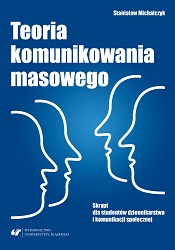Teoria komunikowania masowego. Skrypt dla studentów dziennikarstwa i komunikacji społecznej
The theory of mass communication A textbook for students of journalism and social communication
Author(s): Stanisław Michalczyk
Subject(s): Social Sciences, Media studies, Communication studies, Theory of Communication
Published by: Wydawnictwo Uniwersytetu Śląskiego
Keywords: the script; manual; journalism; Social Communication; mass communication
Summary/Abstract: The purpose of this textbook is to present the students of journalism and social communication with the foundations of the modern theory of mass communication. The work is intended also for students who pursue other fields of study, which offer specialisation in journalism and communication (communicological specialisation), e.g. the students of political science, Polish philology, sociology or economics. The book may also be of interest to journalists, people employed in the sector of Public Relations, advertising, and promotion, as well as departments of various public institutions. It will certainly be of interest to specialists in the field of media studies, mainly the theoreticians of mass communication.The relatively complex subject of the theory of mass communication is explored by the author in two dimensions – he examines it from three perspectives:• the scholarly and historical perspective;• the scholarly and the current perspective;• the scholarly and personal perspective.Another purpose of the textbook is to introduce scholarly and didactic order and to categorise the problems of the theory of mass communication so that it may constitute a didactic basis for people who hold classes or lectures in this subject at Polish universities or in other institutions of higher education.The textbook consists of 10 chapters:• Chapter 1: The transdisciplinary nature of the science of the media and communication is an introduction to the whole array of the problems of the theory of mass communication. It discusses the essence and the structure of the discipline, which examines and describes the processes of communication and the role of the media in the said processes.• Chapter 2: The historical development of communication and the media furnishes historical data about the development of the media and (mass) communication during the course of a few centuries, with special reference to the last few decades, when a gradual “densification” of the phenomena and processes which led to the emergence of a media society occurred. The media-related and technological advancements were an important factor in the social development in all periods of history, but their particular intensification occurred after the Second World War.• Chapter 3: Communication – mass communication – the media defines the basic concepts, explains the relevant terms (mass communication, the media and their functions), describes the models of mass communication and constitutes an attempt at representing in a general manner the essence of the processes of communication with an indication of the differences between mass (mediated) and interpersonal (non-mediated) communication.• Chapter 4: Base theories – discusses 10 theories which are crucial for the theory of mass communication. Their presentation is preceded by an explanation of the concept theory (in the context of mass communication) and an indication of the criteria of the classification of theories.• Chapter 5: The middle range theories discusses the theories – ones which are popular in thescience of the media and communication – which are constrained in terms of area and semantics and which are empirically verifiable at the same time. The creator of the paradigm was Robert K. Merton, who reduced the gap between the world of great (general) social theories and the world of microscopic (particular) observation of communication-related phenomena. Each of the theories is briefly discussed in a certain logical order: the history, the theoretical premises, the research methods, empirics. There is also an indication of the similarities to other cognate theories and the relations between them.• Chapter 6: The forms of public communication. The actors and the processes introduces order to the area of mass communication due to the forms which occur in it, forms such as journalism, Public Relations and advertising.• Chapter 7: The structures and the contexts of the media analyses the subdisciplines and the constituent disciplines of the science of the media and communication which are particularly important from the point of view of the theory and practice: the media-related policy, the sociology of the media, the economics of the media, the media-related pedagogy and the media law. The chapter focuses on the explanation of the essence of each of the subdisciplines and their structures.• Chapter 8: The content of the media explains the basic problems associated with the fourth question of Lasswell’s formula (“what is said”). The content (the substance) determines the potential conditions of the social and cultural impact of mass media in a shorter and in a longer period of time. This content holds the foundations of manipulation and demagogy.• Chapter 9: The use and the reception of the media is devoted to the social and the individual reception of the media. It analyses above all the nature and the features of the recipients of the modern media (recipients as a “mass”, recipients as a target group, recipients as a commodity, recipients as a victim, recipients as an active, thinking user).• Chapter 10: The results of the impact of the media, which in a sense constitutes a conclusion of the whole work, explains the processes of the impact of the media upon the individual and the society. Each chapter is followed by test questions, which enable verification of the extent of the knowledge which was acquired in a given field. The textbook provides basic knowledge. In order to gain in-depth and extensive knowledge, one must consult the supplementary works which are listed at the end of each chapter. A complete listing is provided in the bibliography, which also contains additional items.
Series: Radio, Telewizja, Film, Internet
- E-ISBN-13: 978-83-226-3452-3
- Print-ISBN-13: 978-83-226-3451-6
- Page Count: 256
- Publication Year: 2019
- Language: Polish
- eBook-PDF
- Table of Content
- Introduction

